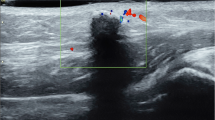Abstract
Objective
The purpose of this study was to analyze statistically significant diagnostic factors for pilomatricoma on the basis of ultrasonographic features.
Methods
Sonographic images were retrospectively reviewed from 44 pilomatricomas, and from 43 control subjects with other subcutaneous tumors. Two radiologists determined the tumoral shape, margin, echotexture, echogenicity, posterior shadowing, posterior enhancement, hypoechoic rim, internal calcification, and vascularity.
Results
The reliable diagnostic factors for pilomatricoma were hypoechogenicity (P < 0.001), heterogenicity (P < 0.05), internal calcification (P < 0.001), hypoechoic rim (P < 0.001), and posterior shadowing (P < 0.001). Scattered dots were the most common patterns of internal calcification. A combination of hypoechogenicity, heterogenicity, internal calcification of scattered-dot pattern, and a hypoechoic rim was a statistically significant difference between the two groups (P < 0.001; odds ratio, 21).
Conclusions
The features of heterogeneous echotexture, internal echogenic foci in scattered-dot pattern, and a hypoechoic rim or posterior shadowing itself could be discriminative ultrasonographic criteria for differentiating pilomatricomas from other subcutaneous tumors.


Similar content being viewed by others
References
Wolff K, Goldsmith LA, Katz SI. Fitzpatrick's Dermatology In General Medicine. New York: McGraw-Hill; 2007.
Knight PJ, Reiner CB. Superficial lumps in children: what, when, and why? Pediatrics. 1983; 72: 147–153.
Marrogi AJ, Wick MR, Dehner LP. Pilomatrical neoplasms in children and young adults. Am J Dermatopathol. 1992; 14: 87–94.
Pirouzmanesh A, Reinisch JF, Gonzalez-Gomez I, Smith EM, Meara JG. Pilomatrixoma: a review of 346 cases. Plast Reconstr Surg. 2003; 112: 1784–1789.
Kumaran N, Azmy A, Carachi R, Raine PAM, Macfarlane JH, Howatson AG. Pilomatrixoma—accuracy of clinical diagnosis. J Pediatr Surg. 2006; 41: 1755–1758.
Fink AM, Berkowitz RG. Sonography in preauricular pilomatrixoma of childhood. Annals Otol Rhinol Laryngol. 1997; 106: 167–169.
Hughes J, Lam A, Rogers M. Use of ultrasonography in the diagnosis of childhood pilomatrixoma. Pediatr Dermatol. 1999; 16: 341–344.
Lee KH, Kim HJ, Suh CH. Pilomatricoma in the head and neck: CT findings in three patients. J Comput Assist Tomogr. 2000; 24: 332–335.
Masih S, Sorenson SM, Gentili A, Seeger LL. Atypical adult non-calcified pilomatricoma. Skeletal Radiol. 2000; 29: 54–56.
Hwang JY, Lee SW, Lee SM. The common ultrasonographic features of pilomatricoma. J Ultrasound Med. 2005; 24: 1397–1402.
Lim HW, Im SA, Lim G-Y, et al. Pilomatricomas in children: imaging characteristics with pathologic correlation. Pediatr Radiol. 2007; 37: 549–555.
Hsieh T-J, Wang C-K, Tsai K-B, Chen Y-W. Pilomatricoma: magnetic resonance imaging and pathological evaluation. J Comput Assist Tomogr. 2008; 32: 320–323.
Ulrich J, Wesarg I. High-frequency ultrasound in the diagnosis of pilomatrixoma. Pediatr Dermatol. 2001; 18: 163.
Forbis RJ, Helwig E. Pilomatrixoma (calcifying epithelioma). Arch Dermatol. 1961; 83: 606–618.
Elder DE, Johnson BL, Elenitsas R. Lever's histopathology of the skin. 9th ed. Baltimore: Lippincott Williams & Wilkins; 2004.
Malherbe A, Chenantais J. Note sur l’epitheliome calcifie des glandes sebacees. Prog Med. 1880; 8: 826–828.
Pujol RM, Casanova JM, Egido R, Pujol J, de Moragas JM. Multiple familial pilomatricomas: a cutaneous marker for Gardner syndrome? Pediatr Dermatol. 1995; 12: 331–335.
Demircan M, Balik E. Pilomatricoma in children: a prospective study. Pediatr Dermatol. 1997; 14: 430–432.
Kajino Y, Yamaguchi A, Hashimoto N, Matsuura A, Sato N, Kikuchi K. beta-Catenin gene mutation in human hair follicle-related tumors. Pathol Int. 2001; 51: 543–548.
Xia J, Urabe K, Moroi Y, et al. beta-Catenin mutation and its nuclear localization are confirmed to be frequent causes of Wnt signaling pathway activation in pilomatricomas. J Dermatol Sci. 2006; 41: 67–75.
Kaddu S, Soyer HP, Cerroni L, Salmhofer W, Hödl S. Clinical and histopathologic spectrum of pilomatricomas in adults. Int J Dermatol. 1994; 33: 705–708.
Behnke N, Schulte K, Ruzicka T, Megahed M. Pilomatricoma in elderly individuals. Dermatology. 1998; 197: 391–393.
Danielson-Cohen A, Lin SJ, Hughes CA, An YH, Maddalozzo J. Head and neck pilomatrixoma in children. Arch Otolaryngol Head Neck Surg. 2001; 127: 1481–1483.
Lan M-Y, Lan M-C, Ho C-Y, Li W-Y, Lin C-Z. Pilomatricoma of the head and neck: a retrospective review of 179 cases. Arch Otolaryngol Head Neck Surg. 2003; 129: 1327–1330.
Aslan G, Erdoğan B, Aköz T, Görgü M, Seçkin S, Terzioğlu A. Multiple occurrence of pilomatrixoma. Plast Reconstr Surg. 1996; 98: 510–513.
Fujioka M, Gozo N, Osamu M, Tsuneyuki Y, Takehisa Y. Secondary anetoderma overlying pilomatrixomas. Dermatology. 2003; 207: 316–318.
Fernández-Flores A, Gonzalez-Montero J-M. Anetodermic variant of pilomatricoma. Int J Dermatol. 2005; 44: 876–877.
Duflo S, Nicollas R, Roman S, Magalon G, Triglia JM. Pilomatrixoma of the head and neck in children: a study of 38 cases and a review of the literature. Arch Otolaryngol Head Neck Surg. 1998; 124: 1239–1242.
De Beuckeleer LH, De Schepper AM, Neetens I. Magnetic resonance imaging of pilomatricoma. Eur Radiol. 1996; 6: 72–75.
Phyu KK, Bradley PJ. Pilomatrixoma in the parotid region. J Laryngol Otol. 2001; 115: 1026–1028.
Author information
Authors and Affiliations
Corresponding author
Additional information
This work was supported by the 2005 Inje University Research Grant and Busan Paik Hospital Imaging Research Institute
Rights and permissions
About this article
Cite this article
Choo, H.J., Lee, S.J., Lee, Y.H. et al. Pilomatricomas: the diagnostic value of ultrasound. Skeletal Radiol 39, 243–250 (2010). https://doi.org/10.1007/s00256-009-0678-x
Received:
Revised:
Accepted:
Published:
Issue Date:
DOI: https://doi.org/10.1007/s00256-009-0678-x




